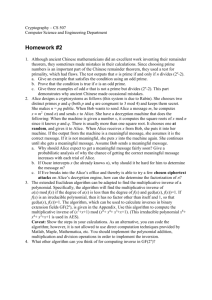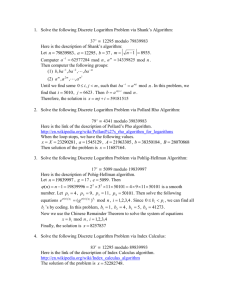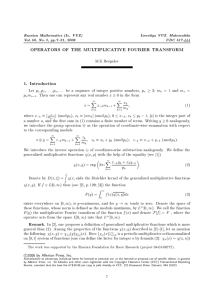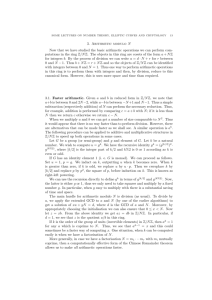Lecture 8
advertisement
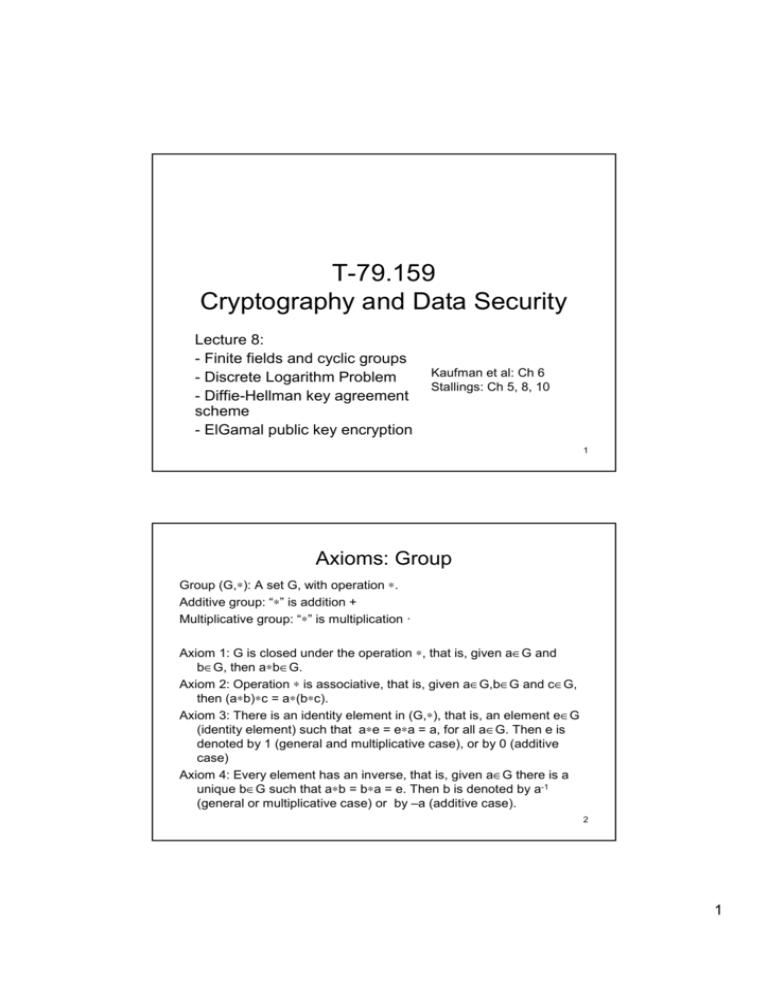
T-79.159
Cryptography and Data Security
Lecture 8:
- Finite fields and cyclic groups
- Discrete Logarithm Problem
- Diffie-Hellman key agreement
scheme
- ElGamal public key encryption
Kaufman et al: Ch 6
Stallings: Ch 5, 8, 10
1
Axioms: Group
Group (G,∗): A set G, with operation ∗.
Additive group: “∗” is addition +
Multiplicative group: “∗” is multiplication ·
Axiom 1: G is closed under the operation ∗, that is, given a∈G and
b∈G, then a∗b∈G.
Axiom 2: Operation ∗ is associative, that is, given a∈G,b∈G and c∈G,
then (a∗b)∗c = a∗(b∗c).
Axiom 3: There is an identity element in (G,∗), that is, an element e∈G
(identity element) such that a∗e = e∗a = a, for all a∈G. Then e is
denoted by 1 (general and multiplicative case), or by 0 (additive
case)
Axiom 4: Every element has an inverse, that is, given a∈G there is a
unique b∈G such that a∗b = b∗a = e. Then b is denoted by a-1
(general or multiplicative case) or by –a (additive case).
2
1
Axioms: Abelian Group
Axiom 5: Group (G,∗) is Abelian group (or commutative
group) if the operation ∗ is commutative, that is, given
a∈G and b∈G, then a∗b = b∗a.
3
Axioms: Ring (R,+,·)
A set R with two operations + and · is a ring if the following
eight axioms hold:
A1: Axiom 1 for +
A2: Axiom 2 for +
(R,+) is an Abelian Group
A3: Axiom 3 for +
A4: Axiom 4 for +
A5: Axiom 5 for +
M1: Axiom 1 for ·
M2: Axiom 2 for ·
M3: Distributive laws hold, that is, given a∈G,b∈G and
c∈G, then a·(b+c) = a·b+a·c and (a+b)·c = a·c+b·c.
4
2
Axioms: Commutative Ring and Field
A ring (R,+,·) is commutative if
M4: Axiom 5 for multiplication holds
A commutative ring (F,+,·) is a field if :
M5: Axiom 3 for · in F-{0}, that is, a∗1 = 1∗a = a, for all a∈F, a≠0.
M6: Axiom 4 for · in F-{0}, that is, given a∈F, a≠0, there is a unique
a-1∈F such that a∗ a-1 = a-1∗a = 1.
If (F,+,·) is a field, then F∗ = F-{0} with multiplication is a group.
Example: p prime, then Zp ={a | 0≤a<p} with modulo p addition and
multiplication is a field and (Zp∗,·) is a group.
5
Polynomial Arithmetic
• Modular arithmetic with polynomials
• We limit to the case where polynomials have binary
coefficients, that is, 1+1 = 0, and + is the same as -.
Example:
( x 2 + x + 1)( x 3 + x + 1) =
x5 + x3 + x 2 + x 4 + x 2 + x + x3 + x + 1 =
x 5 + x = x ⋅ ( x 4 + 1) = x ⋅ x = x 2 (mod( x 4 + x + 1))
Computation mod( x + x + 1) means that everywhere
4
we take x + x + 1 = 0 ,which means, for example, that
4
x 4 + 1 = x.
6
3
Galois Field
Given a binary polynomial f(x) of degree n, consider a set
of binary polynomials with degree less than n. This set
has 2n polynomials. With polynomial arithmetic modulo
f(x) this set is a ring.
Faxt: If f(x) is irreducible, then this set with 2-ary (binary)
polynomial arithmetic is a field denoted by GF(2n).
In particular, every nonzero polynomial has a
multiplicative inverse modulo f(x). We can compute a
multiplicative inverse of a polynomial using the
Extended Euclidean Algorithm.
Example: Compute the multiplicative inverse of x2 modulo
x4 +x+1
7
Extended Euclidean Algorithm for polynomials
Example
ri
ui
vi
-2
x4 +x+1
0
1
-1
x2
1
0
i
qi
0
x2
x+1
x2
1
1
x
x
x3+1
x
2
1
1
x3+x2+1 x+1
8
4
Extended Euclidean Algorithm for polynomials
Example cont’d
So we get
u2⋅x2 + v2⋅(x4 +x+1) = (x3+x2+1)x2 +(x+1)(x4 +x+1)
from where the multiplicative inverse of x2 modulo x4
+x+1 is equal to x3+x2+1.
Motivation for polynomial arithmetic:
• uses all n-bit numbers
• provides uniform distribution of the multiplication
result
9
Example: Modulo 23 arithmetic compared to
GF(23) arithmetic (multiplication).
In GF(2n) arithmetic, we identify polynomials of degree
less than n:
2
n −1
a0 + a1 x + a2 x + L + an −1 x
with bit strings of length n:
(a0 , a1 , a2 , K , an −1 )
and further with integers less than 2n:
a0 + a1 2 + a2 2 2 + L + an −1 2 n −1
Example: In GF(23) arithmetic with polynomial x3+x+1
(see next slide) we get:
4⋅3 = (100) ⋅(011) = x2⋅ (x+1)= x3 + x2 = (x+1) + x2 = x2 +
x+1 = (111) = 7
10
5
Multiplication tables
modulo 8 arithmetic
0
1
2
3
4
5
6
7
0
0
0
0
0
0
0
0
0
1
0
1
2
3
4
5
6
7
2
0
2
4
6
0
2
4
6
3
0
3
6
1
4
7
2
5
GF(23) Polynomial arithmetic
4
0
4
0
4
0
4
0
4
5
0
5
2
7
4
1
6
3
6
0
6
4
2
0
6
4
2
7
0
7
6
5
4
3
2
1
0
0
0
0
0
0
0
0
0
0
1
2
3
4
5
6
7
1
0
1
2
3
4
5
6
7
2
0
2
4
6
3
1
7
5
3
0
3
6
5
7
4
1
2
4
0
4
3
7
6
2
5
1
5
0
5
1
4
2
7
3
6
6
0
6
7
1
5
3
2
4
7
0
7
6
2
1
6
4
3
11
Generated set
Example: Finite field Z19
g=7
gi mod 19
i
gi
0
1
1
7
2
49=11
3
77=1
4
7
5
11
…
…
12
6
Generated elements
Example: Finite field Z19
g=2
gi mod 19, i = 0,1,2,…
Element a = 2 generates
all nonzero elements in Z19.
Such an element is called
primitive.
i
0
1
2
3
4
5
6
7
8
9
gi
1
2
4
8
16
13
7
14
9
18
i
10
11
12
13
14
15
16
17
18
gi
17
15
11
3
6
12
5
10
1
13
Cyclic subgroups
F finite field, g ∈ F*, let <g> denote the set generated by g;
<g> = {1=g0,g1,g2,…,gr-1}, where r is the least positive
number such that gr=1 in F. By Fermat’s and Euler’s
theorems r ≤ # F*.
r is the order of g.
<g> is a subgroup of the multiplicative group F* of F.
Axiom 1: gi ⋅gj = g i+j ∈ <g>.
Axiom 2: associativity is inherited from F
Axiom 3: 1 = g0 ∈ <g>.
Axiom 4: Given gi ∈ <g> the multiplicative inverse is gr-i ,
as gi⋅gr-i = gr-i⋅gi = gr =1
<g> is called a cyclic group. The entire F* is a cyclic group
generated by a primitive element, e.g, Z19* = <2>.
14
7
Example: Cyclic group in Galois Field
GF(24) with polynomial f(x) = x4 + x + 1
g = 0011= x+1
g2 = x2+1=0101
g3 = (x+1)(x2+1) = x3 + x2 + x + 1 = 1111
g4 = (x+1)(x3 + x2 + x + 1) = x4 + 1 = x = 0010
g5 = (x+1)(x4 + 1) = x5 + x4 + x + 1 = x2 + x = 0110
g6 = (x+1)(x2 + x) = x3 + x = 1010
g7 = (x+1)(x3 + x) = x4 + x3 + x2 + x = x3 + x2 +1= 1101
g8 = (x+1)(x3 + x2 +1) = x4 + x2 +x+1= x2 =0100
g9 = (x+1)x2 = x3 + x2 = 1100
g10 = (x+1)(x3 + x2)= x2 + x + 1= 0111
g11 = (x+1)(x2 + x +1) = x3 + 1 = 1001
g12 = (x+1)(x3 + 1) = x3 = 1000
g13 = (x+1)x3 = x3 + x + 1 = 1011
g14 = (x+1)(x3 + x + 1) = x3 + x2 +x = 1110
g15 = (x+1)(x3 + x2 +x) = 1= 0001
15
Discrete logarithm
Given a ∈ <g> = {1,g1,g2,…,gr-1}, there is x, 0 ≤x < r such
that a =gx. The exponent x is called the discrete
logarithm of a to the base g.
Example: Solve the equation
2 x = 14 mod 19
We find the solution using the table (slide 13): x =7.
Without the precomputed table the discrete logarithm is
often hard to solve. Cyclic groups, where the discrete
logarithm problem is hard, are used in cryptography.
16
8
Diffie-Hellman Key Exchange
ALICE
BOB
a secret
A=
ga
b secret
mod p
B = gb mod p
A
B
K = Ba mod p
K = Ab mod p
17
Security of Diffie-Hellman Key Exchange
•
•
•
•
•
•
If the Discrete Logarithm Problem (DLP) is easy then DH KE is
insecure
Diffie-Hellman Problem (DHP):
Given g,ga,gb, compute gab.
It seems that in groups where the DHP is easy, also the DL is easy.
It is unknown if this holds in general.
DH KE is secure against passive wiretapping.
DH KE is insecure under the active man-in-the-middle attack: Manin-the-Middle exchanges a secret key with Alice, and another with
Bob, while Alice believes that she is talking confidentially to Bob,
and Bob believes he is talking confidentially to Alice (see next slide).
This problem is solved by authenticating the Diffie-Hellman key
exchange messages.
18
9
Man-in-the-Middle in the DH KE
Carl
(man-in-the-middle)
Alice
a
ga
ga
c1
gc1
Bob
gc1
b
gb
gb
gc2
K2= (ga)c2
c2
gc2
K1= (gb)c1
K1= (gb)c1
K2= (ga)c2
Protection using K2
Protection using K1
19
Recall: The Principle of Public Key Cryptosystems
Encryption operation is public
Decryption is private
anybody
Alice
encryption
decryption
Alice’s key for a public key cryptosystem is a pair:
(Kpub,Kpriv) where Kpub is public and Kpriv is cannot be
used by anybody else than Alice.
20
10
Setting up the ElGamal public key cryptosystem
• Alice selects a primitive element g in Zp* .
• Alice generates a, 0< a < p-1, and computes ga mod
p = A.
• Alice’s public key: Kpub = (g, A )
• Alice’s private key: Kpriv = a
• Encryption of message m ∈ Zp* : Bob generates a
secret, unpredictable k, 0< k < p-1. The encrypted
message is the pair (gkmod p, (Ak ⋅m) mod p).
• Decryption of the ciphertext: Alice computes (gk)a= Ak
mod p, and the multiplicative inverse of Ak mod p.
Then m = (Ak ) -1⋅ (Ak ⋅m) mod p.
Diffie-Hellman Key Exchange and ElGamal
Cryptosystem can be generalised to any cyclic group,
where the discrete logarithm problem is hard.
21
11

